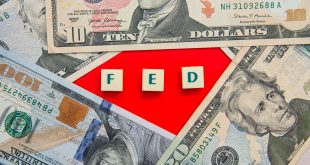Inflation, geopolitical tensions and global growth-linked worries impacted almost all financial markets. EU inflation retreated in October but is still hot. The EUR/USD pair held above the 1.0300 level with no signs of declining.
As the Fed’s battle against inflation arrives at a new and more challenging stage, services will be attentively watched for an indication of where inflation is heading, and what could happen next.
ECB’s Christine Lagarde said, Friday, the central bank will continue to raise interest rates and may even need to restrict economic activity in order to control inflation. “Interest rates are and remain the main tool for adjusting our policy stance,” Lagarde said.
The ECB will publish plans to reduce the balance sheet in December and the process is expected to begin with the bank being allowed to expire some bonds.
The Eurozone Consumer Price Index inflation was revised to 10.6% YoY in October, slightly below the preliminary estimate of 10.7%. The US published Initial Jobless Claims for the week ended November 11, which came down to 222K, better than the previous 226K. October Building Permits declined by 2.4%, while Housing Starts fell by 4.2%, worse than the previous monthly readings.
China is looking to slow crude imports from some sources. China has also seen a rise in COVID-19 cases.
US Dollar
Most support for the US dollar came from government bond yields. The 10-year Treasury note offers 3.76%, while the 2-year one pays 4.46%. The advance is more worrying at the shorter end of the curve.
The yield curve inversion between the 2-year and 10-year Treasury notes deepened to its widest level in four decades. The spread between the 2-year and 10-year extended to a mark of -66 basis points early Thursday, marking the deepest inversion since 1982.
The US Dollar surged on the back of risk off, as traders are increasingly concerned about the Russia-NATO situation and rising coronavirus contagions in China, which may lead to lockdown and could renew supply-chain worries.
Stocks
The stock market bounced in each of the past two weeks on hopes that inflation has finally peaked. Goods prices are falling. The US housing sector is slowing, and producer costs in October came in below expectations.
Equity options worth $2.1 trillion in notional value expired on Friday in the latest monthly event where weekly and monthly options tied to single stocks, equity indexes and exchange-traded funds expire, risking an explosion of volatility across markets.
Global stock markets reflected the investors’ concerns as most indexes edged lower, with US shares posting some losses, after bouncing from their intraday lows ahead of the close.
Gold
Market sentiment would tell a significant part of price action’s story during the trading week. Sentiment shifted because inflation rates have slightly declined and investors viewed this fractional drop as a signal that the Fed would begin to loosen its hawkish tightening cycle.
There are hopes even for Fed to become more dovish regarding upcoming rate hikes. This caused gold to make the bold dramatic jump from $1621 to the intraday high of $1792 by Tuesday, November 15.
One day before the week’s first US session, Fed’s Christopher Waller told a conference Australia, on Sunday November 13, “We’re not softening…Quit paying attention to the pace and start paying attention to where the endpoint is going to be. Until we get inflation down, that endpoint is still a way out there.” On November 14, several Fed officials made comments to the contrary.
Fed’s Mary Daly noted “It’s far from a victory”. Fed’s Lorie Logan said that last week’s report is, “a welcome relief”, but will not alleviate the need for more rate increases possibly at a slower pace.
These and other statements will likely continue to create bearish market sentiment for gold. Fed members dramatically changed market sentiment concerning gold prices. Gold prices hit the intraday high above $1790 the following day and then began to have three consecutive days of price declines from Wednesday to Friday.
To keep this fire blazing, St. Louis Fed’s James Bullard said that the Fed’s benchmark policy right might need to rise as high as 7%, stressing that even dovish stance would require more interest rate hikes.
The statements moved gold pricing from Tuesday’s high to its current price at $1750.40 per ounce after retreating from.
Crypto Market
Betcoin was high trading at $16705 after falling to intraday lows after Wednesday’s Wall Street opening bell as the FTX scandal appeared to have impacted another victim. After the bell BTC/USD was trading around $16,400.
The meant victim could be Genesis Global Capital, the crypto lending arm of Genesis Trading, and so, withdrawals have been paused over liquidity issues.
The Digital Currency Group (DCG), the parent company that counts Genesis Trading among its subsidiaries, directly attributed the decision to the FTX disaster.
FTX’s collapse not only left employees extremely angry, but the company also has more than one million creditors, rather than its initially stated 100,000, according to information in bankruptcy filing.
Oil
Oil fell by about 2% on Friday, recording a second weekly decline, due to concern about weakened demand in China and further increases to US interest rates.
Brent crude settled at $87.62 a barrel, falling $2.16, or 2.4%. WTI crude settled at $80.08 a barrel, losing $1.56, or 1.9%. So, both benchmarks posted weekly losses, with Brent down about 9% and WTI roughly 10%.
The stronger US dollar, which makes oil more expensive to non-American buyers, pushed down crude prices. The market structure of both oil benchmarks shifted in ways that reflect declining supply concerns.
Oil’s Looming Contango
Supply concerns are generally weakening. WTI is trading at a discount for the second month, this is broadly known as “contango”. This could benefit buyers who are looking to put more oil in inventories for later, especially with stockpiles still at low levels.
As the European Union’s ban on Russian crude looms on Dec. 5, the prospect of more barrels from Russia pressuring the spot crude oil market also weighed on futures prices.
Recession concerns have dominated this week even with a tightening of supply by the Organization of the Petroleum Exporting Countries (OPEC) and its allies, together known as OPEC+.
The Fed is expected to raise rates by a smaller 50 basis points at its Dec. 13-14 policy meeting after four consecutive hikes of 75 bps according to Reuters poll.
 Noor Trends News, Technical Analysis, Educational Tools and Recommendations
Noor Trends News, Technical Analysis, Educational Tools and Recommendations





